Actiontec Electronics C802URG MegaBoost 54 Mbps Wireless USB Adapter User Manual 8106936
Actiontec Electronics Inc MegaBoost 54 Mbps Wireless USB Adapter 8106936
Manual
MegaBoost 54Mbps
Wireless USB Adapter
Model Name: C802URG
User’s Guide

i
TABLE OF CONTENT
Introduction ................................................................................................................................... 1
Overview of this User’s Guide................................................................................................... 1
Unpacking and Setup..................................................................................................................... 2
Unpacking................................................................................................................................... 2
Setup ........................................................................................................................................... 2
Hardware Installation .................................................................................................................... 3
LED Indicator............................................................................................................................. 3
Check the installation ................................................................................................................. 3
Software Installation...................................................................................................................... 4
Utility and Driver Installation..................................................................................................... 4
Wireless utility setting................................................................................................................... 7
Link Info ..................................................................................................................................... 7
Configuration.............................................................................................................................. 8
Advanced .................................................................................................................................... 9
Site Survey................................................................................................................................ 12
Technical Specifications.............................................................................................................. 15

1
INTRODUCTION
Congratulations on your purchase of this MegaBoost 54Mbps Wireless USB
Adapter.
This manual helps to get familiar with the MegaBoost 54Mbps Wireless USB
Adapter. This manual contains detailed instructions in operation of this product.
Please keep this manual for future reference.
With a Wireless LAN (IEEE 802.11g) USB 2.0 Adapter, a desktop or laptop
computer can communicate with another computer in a wireless way. Easy-to-use
utilities are bundled with Wireless USB Adapter for configuration, monitoring, and
diagnosis purposes.
The MegaBoost 54Mbps Wireless USB Adapter can wirelessly transmit and receive
data, minimizing the need for wired connections, at a speed of up to fifty-four
megabit per second.
The MegaBoost 54Mbps Wireless USB Adapter provides users with an access to
real-time information anywhere in their organization. The mobility provides
productivity and service, which are not available under wired networks. The
MegaBoost 54Mbps Wireless USB Adapter configuration is easy to change from
peer-to-peer networks, suitable for a small number of users, to full infrastructure
networks of thousands of users that allow roaming around a broad area.
Overview of this User’s Guide
Introduction. Describes the MegaBoost 54Mbps Wireless USB Adapter and its
features.
Unpacking and Setup. Helps you get started with the basic installation of the
MegaBoost 54Mbps Wireless USB Adapter.
Hardware Installation. Describes the LED indicators of the Adapter.
Software Installation. Tells how to setup the driver and the utility setting.
Technical Specifications. Lists the technical specifications of the MegaBoost
54Mbps Wireless USB Adapter.

2
UNPACKING AND SETUP
This chapter provides unpacking and setup information for the MegaBoost 54Mbps
Wireless USB Adapter.
Unpacking
Open the box of the MegaBoost 54Mbps Wireless USB Adapter and carefully
unpack it. The box should contain the following items:
One MegaBoost 54Mbps Wireless USB Adapter
One Driver & Utility CD-ROM
If any item is found missing or damaged, please contact your local reseller for
replacement.
Setup
The setup of the MegaBoost 54Mbps Wireless USB Adapter can be performed
using the following steps:
Visually inspect the USB connector and make sure that it is fully plugged in to
the system’s USB port.
Make sure that there is a well environment that there is no much intrusion to
have a better connection.

3
HARDWARE INSTALLATION
LED Indicator
LINK
The LINK LED lights green when the MegaBoost 54Mbps Wireless USB Adapter
is connected to a network successfully. Otherwise the LINK indicator blinks green
while the MegaBoost 54Mbps Wireless USB Adapter is access the wireless
network.
Check the installation
The LED of the MegaBoost 54Mbps Wireless USB Adapter is clearly visible and
the status of the network link can be seen instantly:
1. When connected to the USB port and the driver were installed, the LNK LED
will start blinking, and it means that the device is starting to scan an 802.11g
wireless device near the MegaBoost 54Mbps Wireless USB Adapter.
2. While the MegaBoost 54Mbps Wireless USB Adapter linked up to the Access
Point or to other Wireless LAN station, the LINK LED will always light up.
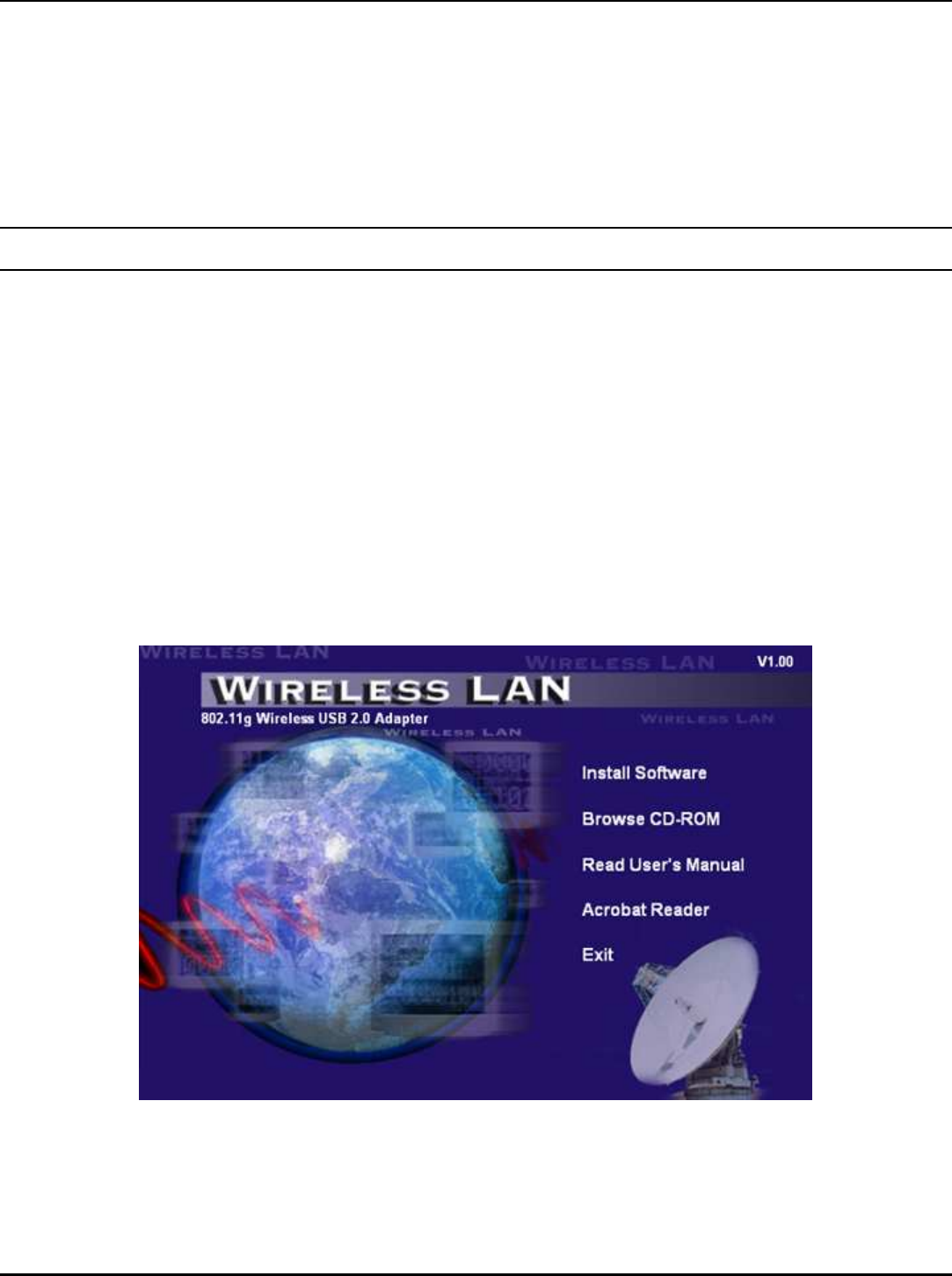
4
SOFTWARE INSTALLATION
This section will lead you to install the driver and utility of the MegaBoost 54Mbps
Wireless USB Adapter.
Before insert the USB Dongle into USB port of your computer, please install
the Utility Program first. Make sure that the MegaBoost 54Mbps Wireless
USB Adapter is NOT inserted into the USB slot.
Utility and Driver Installation
Insert the 802.11g Wireless LAN USB 2.0 Adapter Driver & Utility CD-ROM into
computer’s CD-ROM Drive and it will automatically run a setup menu and install
the driver and the utility. In some specific setting on Windows system, you may
need to proceed the software manually, go to your Windows Start menu and choose
Run, type “D:\Setup\Setup.exe” in the dialog box (D:\ will depend on where your
CD-ROM drive is located).
Note: (D:\ will depends on where the CD-ROM drive is located and <Windows
OS> will depend on the Windows Operating System you are using).
1. Click Install to start the Utility and driver installation.
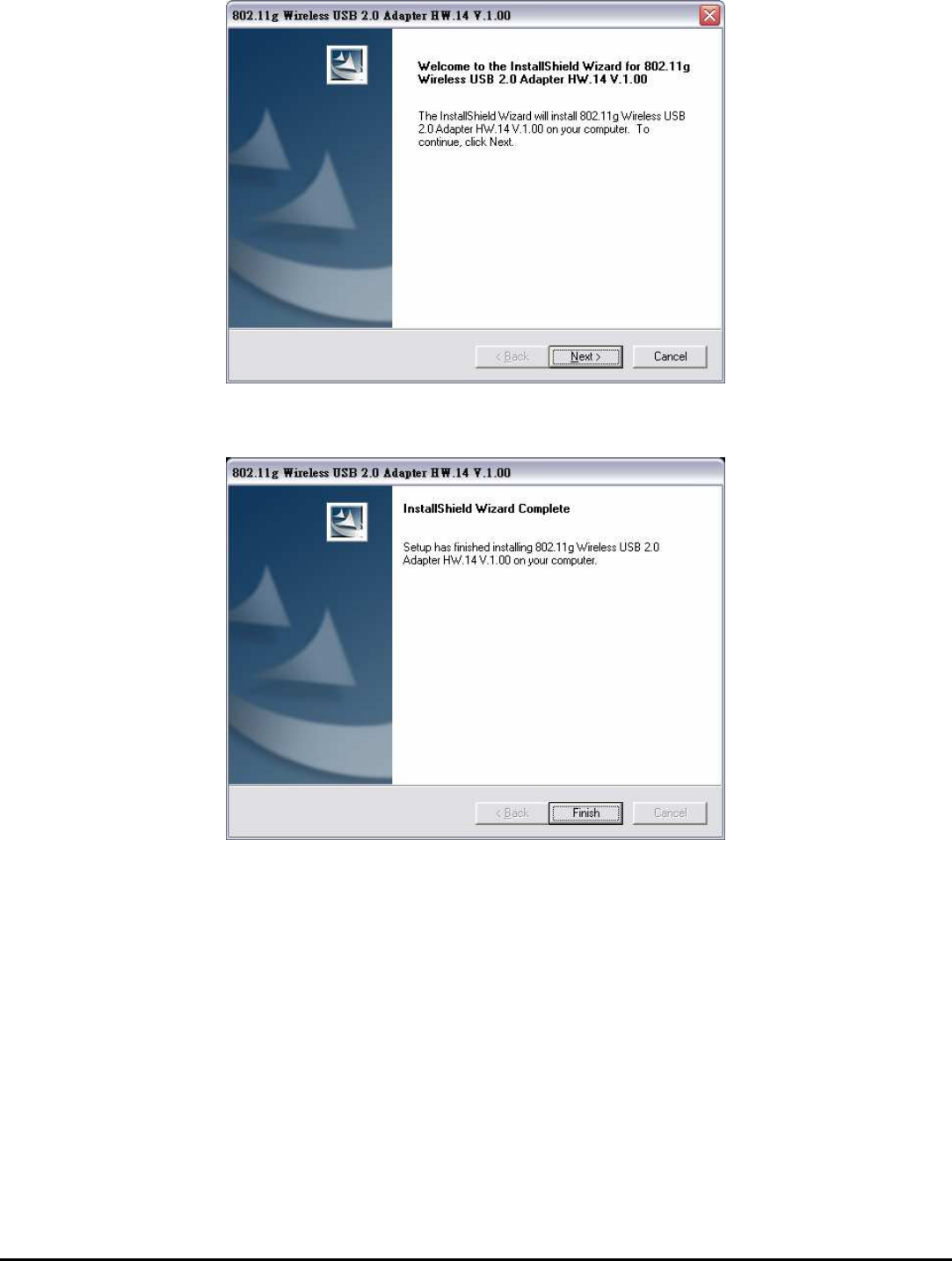
5
2. The Install Shield Wizard screen will appear. Click “Next” to continue.
3. Click “Finish” to finish the installation.

6
4. Plug-in your MegaBoost 54Mbps Wireless USB Adapter into your computer’s
USB port.
5. You will see the icon on the Windows task bar when you finish the utility
installation and plugged the MegaBoost 54Mbps Wireless USB Adapter.
When the icon in the toolbar represents in green color, it is properly connected
to the network and shown the linking quality.
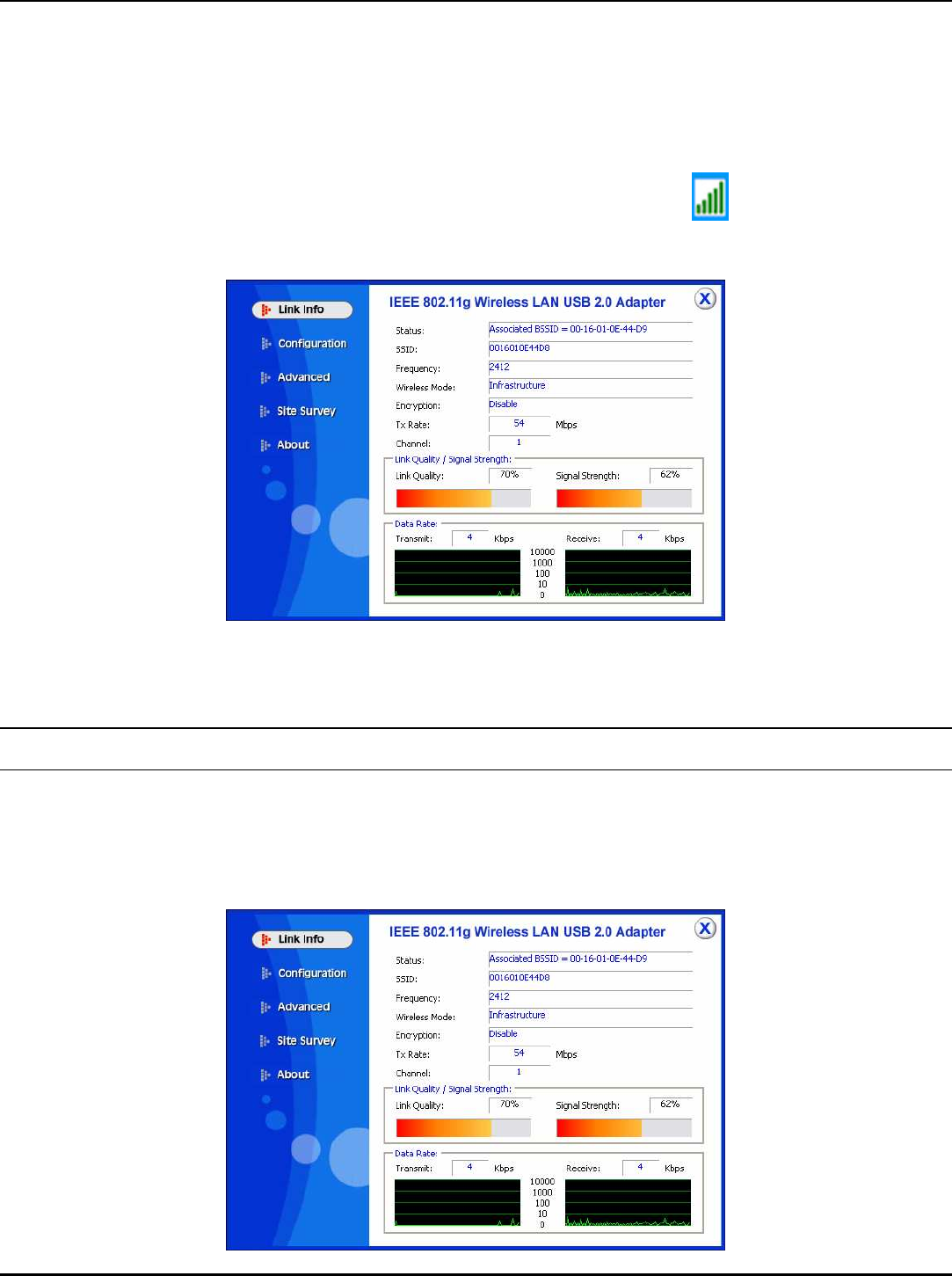
7
WIRELESS UTILITY SETTING
Windows® XP users may use the built-in wireless utility as default. The following
instructions are for Service Pack 2 users. If you are using Windows® 2000/98/ME,
you must use the Wireless Utility.
With the Wireless utility, users can configure all the functions provided by the
Wireless LAN Adapter Utility. Double-click the utility icon that appears in the
system tray.
The Wireless LAN Adapter Utility includes six tabs: Link Info, Configuration,
Advanced, Site Survey and About.
Link Info
The Link Info screen shows you the status of the Wireless Adapter, it shows that
where the device is connected to, the connect Status, the connecting Speed, the
network Type, the Encryption type, the SSID and the Signal Strength.
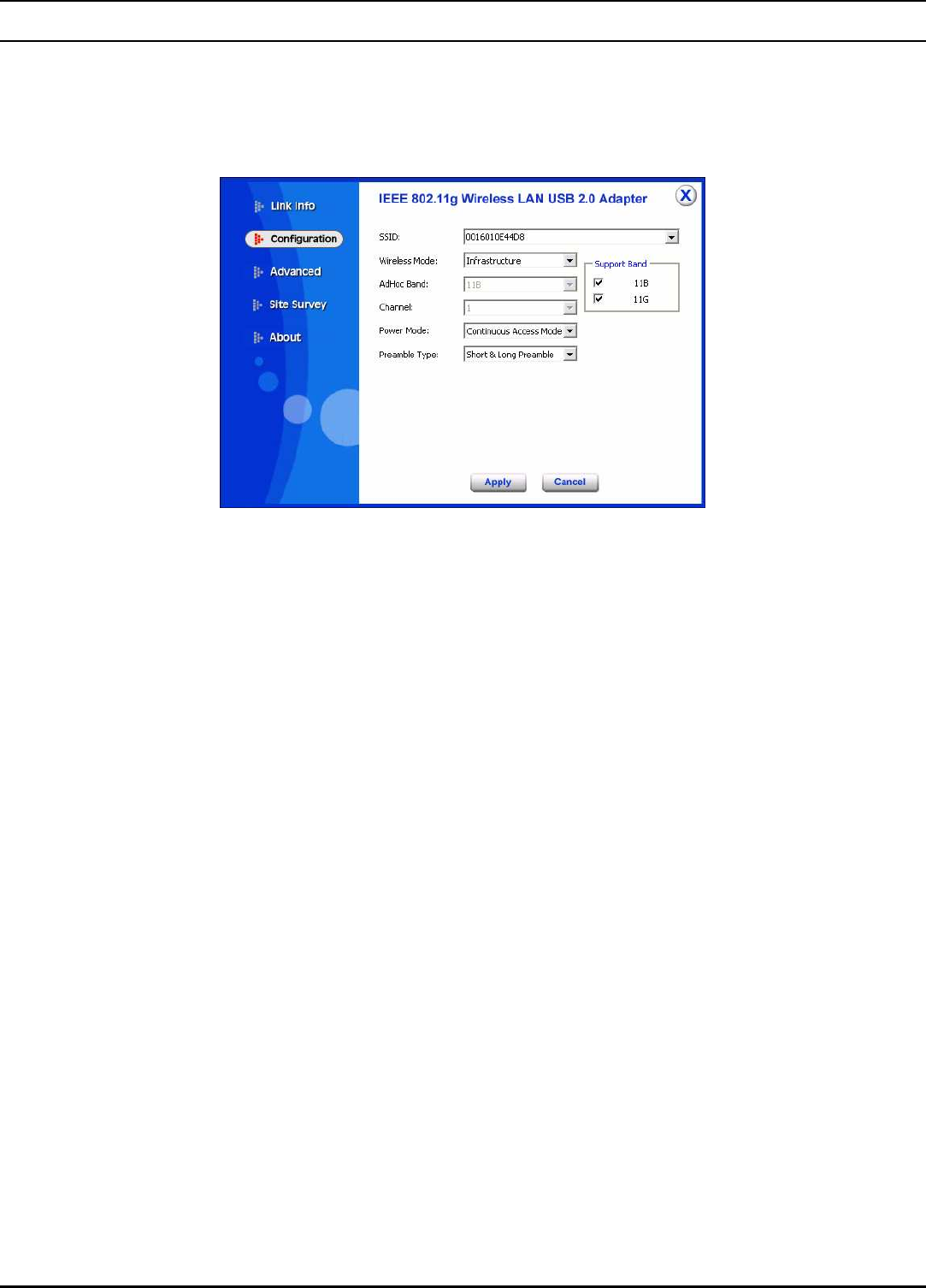
8
Configuration
This is the page where you can change the basic settings of the MegaBoost 54Mbps
Wireless USB Adapter with the minimum amount of effort to implement a secure
wireless network environment.
SSID: The SSID differentiates one Wireless LAN group name from another; so all
access points and all devices attempting to connect to a specific Wireless LAN
group name must use the same SSID. A device will not be permitted to join the
BSS unless it can provide the unique SSID.
Wireless Mode: If you want to connect with an Access Point/WLAN Router,
please set to “Infrastructure” mode. If you have more stations and just want to set
them as local network, please set the mode to “Ad-hoc” mode.
Channel: It shows auto that used for Infrastructure Wireless LAN network. The
channel number can be set only under the Ad-Hoc operation mode. In Ad-Hoc
mode stations, each station must have the same channel number and SSID.
In Infrastructure mode, the Wireless USB Adapter will automatically detect the
channel number of the Access Point.
Power Mode: There are 3 modes to choose:
Continuous Access Mode (default): The USB Dongle is constantly operating
with full power and it consumes the most power.
Maximum Power Save: The USB Dongle consumes the least power and only
operates when there is wireless network activity.
Power Save: The USB Dongle consumes the moderate level of power.
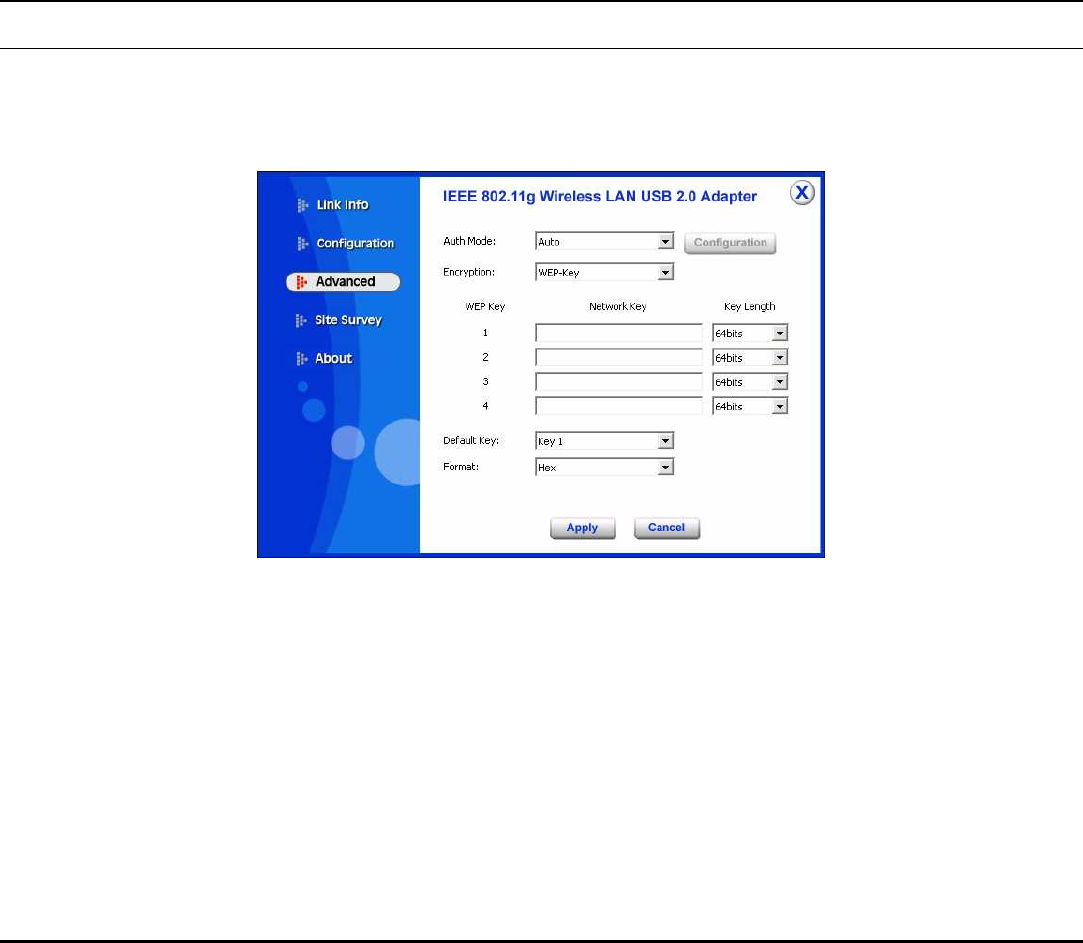
9
Preamble: Select Long or Short/Long (auto) Preamble type. Preamble is a
sequence of bits transmitted at 1Mbps that allows the PHY circuitry to reach
steady-state demodulation and synchronization of bit clock and frame start. Two
different preambles and headers are defined: the mandatory supported Long
Preamble and header, which interoperates with the 1 Mbit/s and 2 Mbit/s DSSS
specification (as described in IEEE Std. 802.11), and an optional Short Preamble
and header (as described in IEEE Std. 802.11b). At the receiver, the Preamble and
header are processed to aid in demodulation and delivery of the PSDU. The Short
Preamble and header may be used to minimize overhead and, thus, maximize the
network data throughput. However, the Short Preamble is supported only from the
IEEE 802.11b (High-Rate) standard and not from the original IEEE 802.11. That
means that stations using Short-Preamble cannot communicate with stations
implementing the original version of the protocol.
Support Band: There are two bands available for selection; 11B and 11G.
Advanced
The Advanced settings help you to control the Wireless Adapter to adjust with
wireless devices in certain environment.
Auth. Mode: Eight options are available: Disable, Auto, Open System, Shared Key,
WPA/WPA2, and WPA-PSK/WPA2-PSK. Select Auto, Disable for other
authentication feature. If one of the two options is selected, it is required to select
the Encryption mode from the next dropping list.
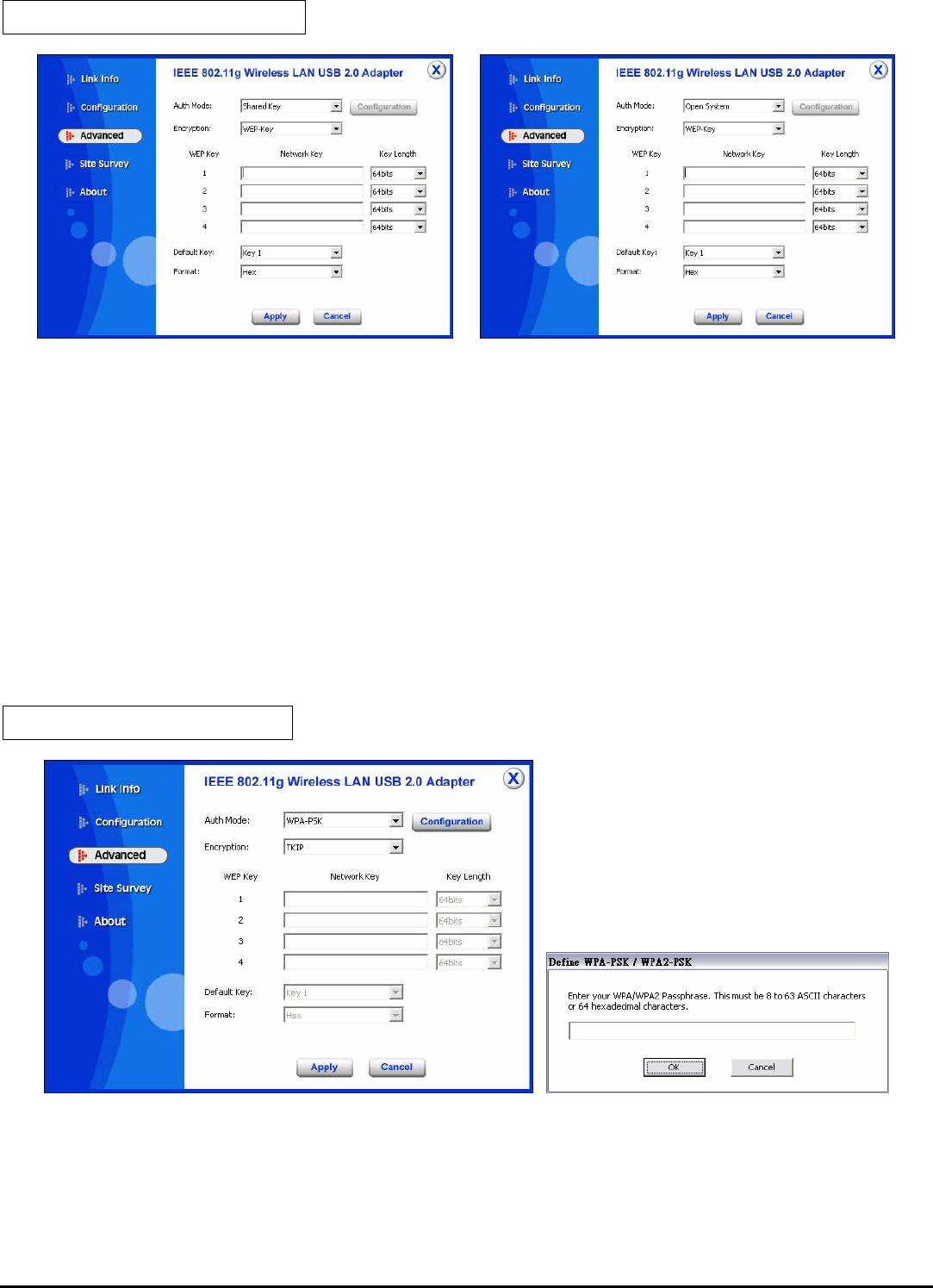
10
Shared Key/Open System
Network Key: Choose the encryption way, either in HEX or ASCII formats, and
enter the password in the blank space.
Key Length, Key Format and WEP Key: If you select 64bit in Hex format, you
must type 10 values in the following range (0~F, hexadecimal), or 64bit in ASCII
format, you must type 5 values in the following range (0~9, A~Z and a~z
Alphanumeric).
If you select 128bit in Hex format, you must type 26 values (0~F, hexadecimal), or
128bit in ASCII format, you must type 13 values in the following range (0~9, A~Z
and a~z Alphanumeric).
WPA-PSK / WPA2-PSK
Click the Configuration button than enter a Passphrase in the Define WPA PSK
dialog box. This Passphrase must be the same on each computer that is connected
to the wireless network.
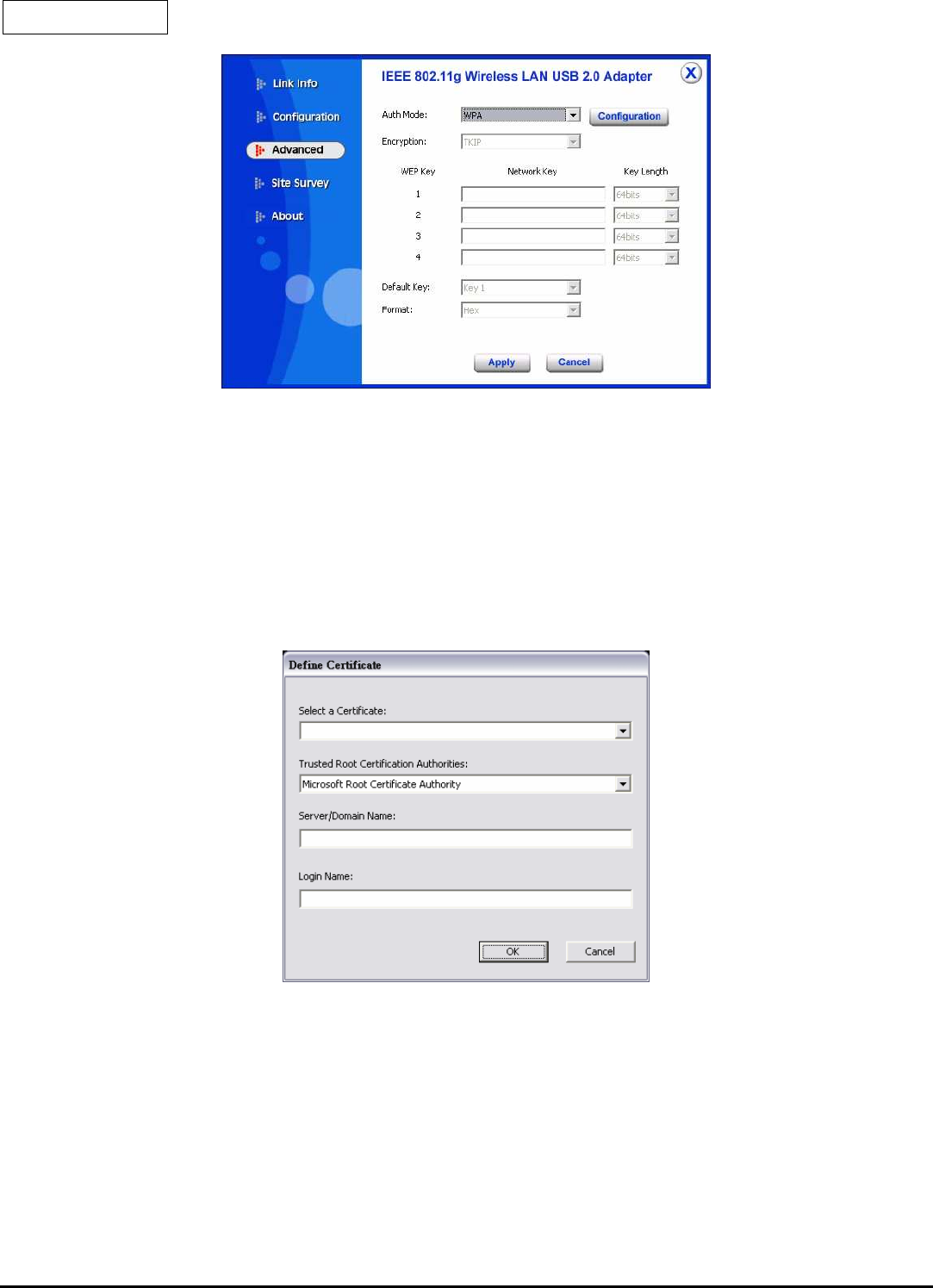
11
WPA / WPA2
WPA2 (Wi-Fi Protected Access 2) is the second generation of WPA; providing
enterprise and consumer Wi-Fi user with a high level of assurance that only
authorized user can access their wireless networks. WPA2 is based on the final
IEEE802.11i amendment to the 802.11 standard and is eligible for FIPS 140-2
compliant. WPA2 is select, configuration is enabled. Please click the
“Certificate” button. The below window is pop up. Then, please select the
certificate that user wants to use and enter the server name and login name.
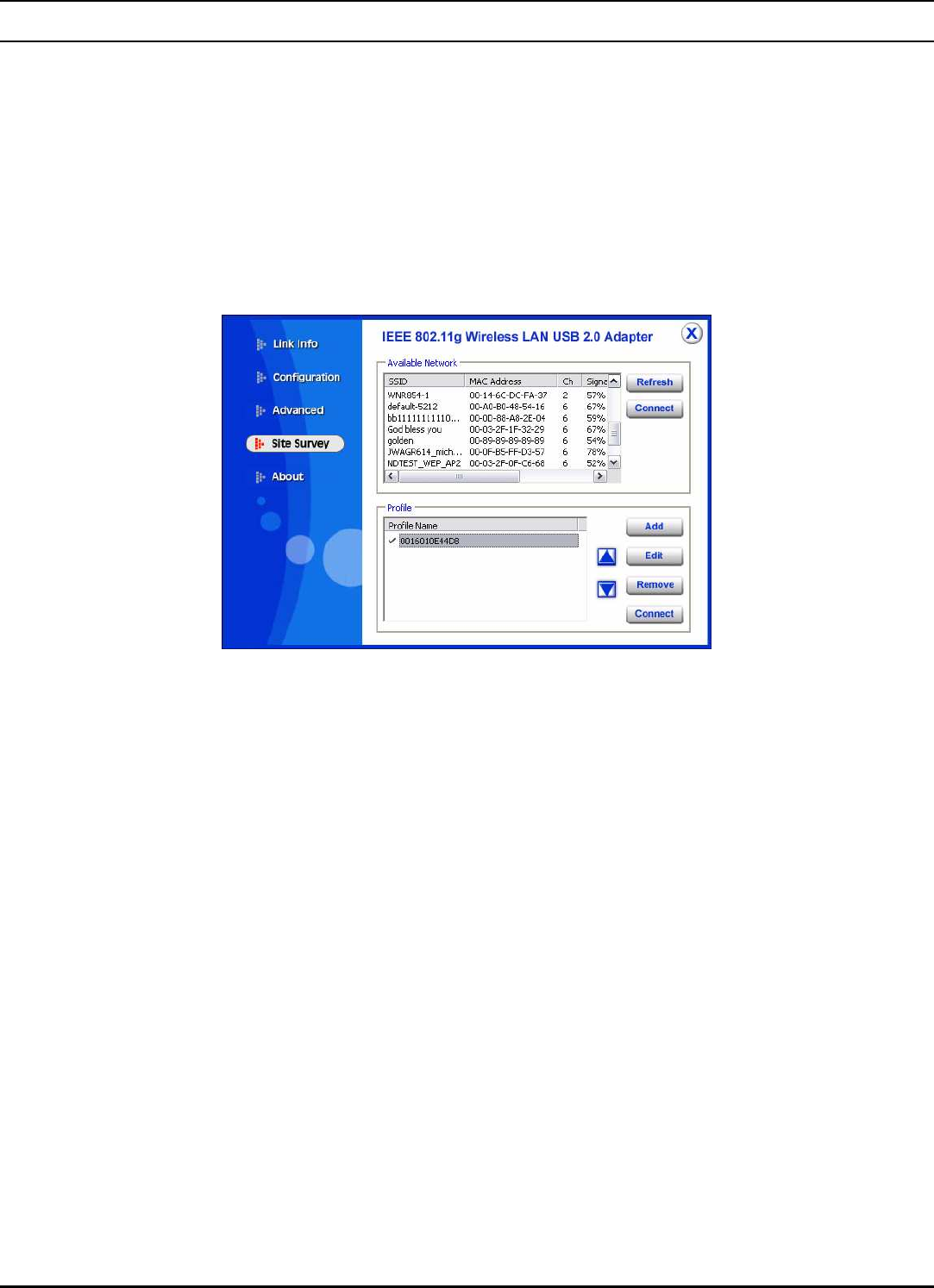
12
Site Survey
Available Network
The screen shows all the Wireless LAN devices around your Wireless LAN USB
Adapter. The information of the wireless devices includes the SSID, MAC Address,
Channels, Signal, the Security type and the Network mode.
You can click the “Refresh” button to find the new wireless LAN devices, and
double-click the device to choose the wireless station that you want to connect with.
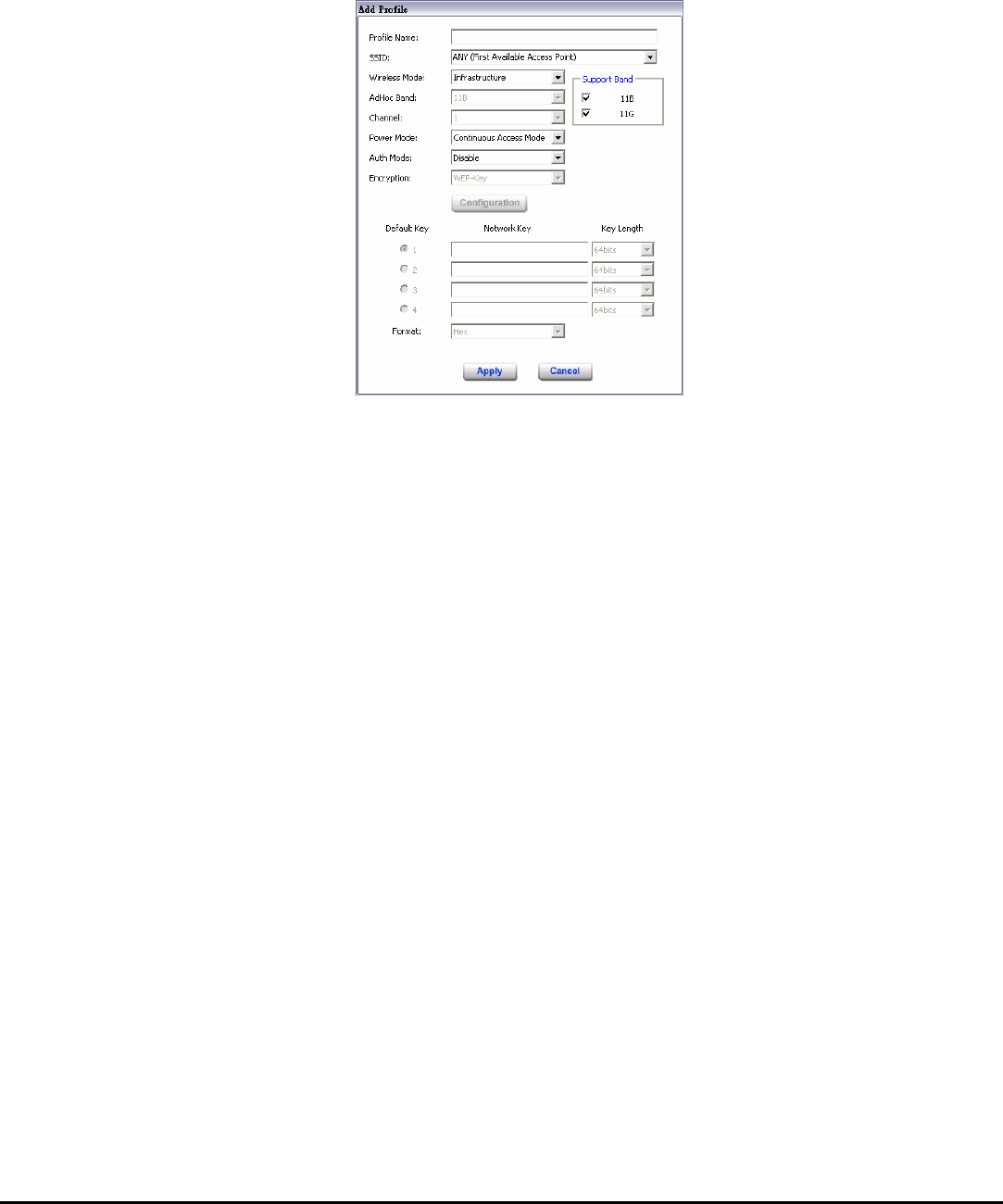
13
Profile
Add: Click “Add” to create a new profile, set the related values such as Profile
name, SSID, Wireless Mode and Security settings than click ”Apply” to save the
profile.
Edit: Click “Edit” to modify existing profile, modify the settings than
click ”Apply” to save the profile.
Remove: Choose a profile name in the “Available Profiles” and click “Remove”
to remove the existing profile.
Connect: Choose a profile name in the “Available Profiles” and click “Connect”
to activate the existing profile.
About
The About section shows you the MegaBoost 54Mbps Wireless USB Adapter
information, it shows MAC address, Utility Version, Driver Version, Regulatory
Domain.

14

15
TECHNICAL SPECIFICATIONS
General
Standards IEEE 802.11g, USB 2.0, 1.1, 1.0
Radio Technology IEEE 802.11b -- DSSS
IEEE 802.11g -- OFDM
Data Transfer Rate 1, 2, 5.5, 6, 9, 11, 12, 18, 24, 36, 48, 54Mbps (auto sense)
Receiver Sensitivity 54Mbps: Typical -68dBm @ 10% PER (Packet Error Rate)
11Mbps: Typical -83dBm @ 8% PER (Packet Error Rate)
Frequency Range 2412 MHz – 2462 MHz (FCC)
2412 MHz – 2472 MHz (ETSI)
2400 MHz – 2497 MHz (Japan)
Modulation Schemes BPSK/QPSK/CCK/OFDM
Channels 1 ~ 11 channels (FCC)
1 ~ 13 channels (ETSI)
1 ~ 14 channels (Japan)
Media Access Protocol
CSMA/CA with ACK
Security 64/128bits WEP, WPA, WPA2, WPA-PSK, WPA2-PSK
Diagnostic LED LNK (Link status)
Antenna Internal printed antenna
Physical and Environmental
Driver Support Windows 98se, Windows 2000, Windows ME, Windows XP
Continuous Current
Consumption 280mA typ. for receive mode, 410mA typ. for transmit mode
Temperature Operating: 0
o
C ~ 40
o
C, Storage: -10
o
C ~ 70
o
C
Humidity 10% ~ 95% RH, no condensation
Dimensions 77 x 26 x 12 mm (W x H x D)
Certifications FCC Part 15.247 for US, ETS 300 328 for Europe,

16
Federal Communication Commission Interference Statement
This equipment has been tested and found to comply with the limits for a Class B digital device, pursuant to Part 15 of the
FCC Rules. These limits are designed to provide reasonable protection against harmful interference in a residential
installation. This equipment generates, uses and can radiate radio frequency energy and, if not installed and used in
accordance with the instructions, may cause harmful interference to radio communications. However, there is no
guarantee that interference will not occur in a particular installation. If this equipment does cause harmful interference to
radio or television reception, which can be determined by turning the equipment off and on, the user is encouraged to try
to correct the interference by one of the following measures:
- Reorient or relocate the receiving antenna.
- Increase the separation between the equipment and receiver.
- Connect the equipment into an outlet on a circuit different from that
to which the receiver is connected.
- Consult the dealer or an experienced radio/TV technician for help.
FCC Caution: Any changes or modifications not expressly approved by the party responsible for compliance could void
the user's authority to operate this equipment.
This device complies with Part 15 of the FCC Rules. Operation is subject to the following two conditions: (1) This device
may not cause harmful interference, and (2) this device must accept any interference received, including interference that
may cause undesired operation.
IMPORTANT NOTE:
Radiation Exposure Statement:
This equipment complies with FCC radiation exposure limits set forth for an uncontrolled environment. End users must
follow the specific operating instructions for satisfying RF exposure compliance. To maintain compliance with FCC RF
exposure compliance requirements, please follow operation instruction as documented in this manual.
This transmitter must not be co-located or operating in conjunction with any other antenna or transmitter.
SAR compliance has been established in typical laptop computer(s) with USB slot, and product could be used in typical
laptop computer with USB slot. Other application like handheld PC or similar device has not been verified and may not
compliance with related RF exposure rule and such use shall be prohibited.
The availability of some specific channels and/or operational frequency bands are country dependent and are firmware
programmed at the factory to match the intended destination. The firmware setting is not accessible by the end user.